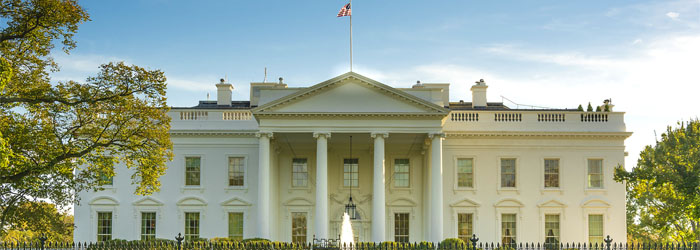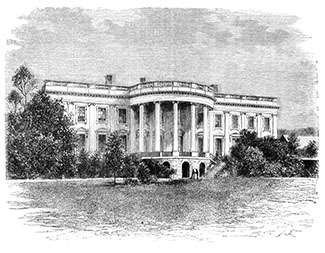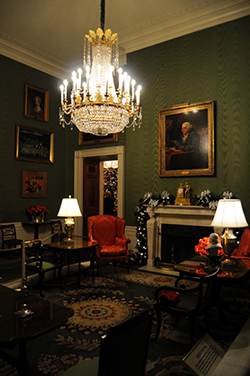Historic Renovations of the White House
 11 February 2020
11 February 2020 

The House We All Share
Have you ever thought about buying a historic home? They can be pricey to keep up. We don't have many really old homes in Arizona but, imagine caring for a home that is 100 years old or older?
If you are a taxpaying American citizen, you are partial owner of the 200-year-old White House. Located at 1600 W Pennsylvania Ave SW, Washington D.C. This structure has seen its share of rescue and renovation.
In Honor of Presidents Day, February 17th, we decided to take a look at a few of the significant changes it has gone through. Much of this information has been provided by the official White House Museum as well as our friend Dr. David Dean, Assistant Professor, History at Grand Canyon University.
George Washington arranged the building of the first White House and construction began in 1792. The neo-classical design of the executive residence was modeled after a palace in Dublin, Ireland by an Irish Architect designed by Irish Architect, James Hoban and hired by Washington. John Adams who succeeded Washington was the first President to actually live there, even though in 1800, when he moved in, it was still unfinished. The cost of that first building was $232,372. It is hard to translate that into current dollars but, experts say it could be anywhere from $4.4 million to as much as $8 billion in modern money.
The first remodel was due to a fire. In 1814, 4,000 British soldiers invaded Washington, D.C. during the War of 1812 and torched the interior in retaliation for the attack on the city of York in Ontario, Canada in 1813. When the British arrived at the White House, President James Madison and first lady Dolly had already fled. Soldiers reportedly sat down to eat a meal made of leftover food from the White House scullery using, White House dishes and silver before ransacking the presidential mansion and setting it ablaze. Madison recalled Architect James Hoban to direct a reconstruction of the house. Though the work was accomplished in slightly less than 3 years, Hoban altered the structural scheme of the house by substituting timber for brick in some of the interior partitions. The shortcut saved time but produced a weaker structure.
Certainly, the White House was the grandest home in America until well into the 1800's, but life the conveniences we enjoy came slowly.
- The first toilet was installed by Thomas Jefferson (1801-1809). A wooden outhouse was demolished and two water closets were installed upstairs. Millard Filmore (1850-1853) gets credit for the first flush toilet
- Running water was welcomed in 1833
- 1837 and 1848 brought heating and gas lights respectively.
- Running hot water was first piped into a bathroom in 1853. And that's when the first permanent bathtub was installed.
1902, saw serious erosion at the White House. Theodore Roosevelt rejected the proposal to rebuild and expand the structure. He chose to keep improvements to a minimum with updated furniture, adding bathrooms and an elevator and moving a staircase. In addition, electric lights replaced old gaslight fixtures.
When Harry Truman became president after Franklin Delano Roosevelt died, the White House had really become a fixer- upper due to all the repairs postponed during the Depression and World War 11. Floors creaked and swayed, a bathroom in the First Family's living quarters was sinking into the floor, plaster walls were sagging, and wooded beams grew weak from previous work.
 It was past time for a remodel. The Truman's moved across the street into the Blair House for three years while the White House underwent a complete reconstruction from 1949-1952. Managed by the Renovation of the Executive Mansion (I would have liked to be on that committee!), the modern transformation of the White House retained the historic sandstone walls, the third floor and the roof, while removing and then rebuilding the other interiors on a skeleton of steel structural beams and a new concrete foundation. Where once the White House had nearly collapsed from its structural deficiencies, now 660 tons of steel strengthened the new concrete inner walls and floors. Although retaining much of its historic appearance, the interior of the house was stunningly dressed in new paint, wall coverings, parquet flooring and tile. The repairs cost $5.7 million at that time.
It was past time for a remodel. The Truman's moved across the street into the Blair House for three years while the White House underwent a complete reconstruction from 1949-1952. Managed by the Renovation of the Executive Mansion (I would have liked to be on that committee!), the modern transformation of the White House retained the historic sandstone walls, the third floor and the roof, while removing and then rebuilding the other interiors on a skeleton of steel structural beams and a new concrete foundation. Where once the White House had nearly collapsed from its structural deficiencies, now 660 tons of steel strengthened the new concrete inner walls and floors. Although retaining much of its historic appearance, the interior of the house was stunningly dressed in new paint, wall coverings, parquet flooring and tile. The repairs cost $5.7 million at that time.
Presidents that followed Truman have primarily done restoration and redecoration with the most famous being the campaign by Jackie Kennedy to decorate the White House with genuine period furniture. The Kennedys had the White House declared a museum and the First Lady sought gifts of antique furniture and financial donations for the renovation. In 1962, she led a tv tour of the finished restoration that an estimated 80 million viewers watched.
Other first families made less publicized renovations: President Franklin Delano Roosevelt had an indoor swimming pool built in 1933. Richard Nixon built a one- lane bowling alley in the basement, and in 1975 president Gerald Ford installed an outdoor pool. Ronald Reagan set up an exercise room in a bedroom, Hilary Clinton converted a third-floor room into a music room for her husband and George and Laura Bush renovated the family theater and press briefing room. There was also a tennis court built in 1902, which was moved Later President Barack Obama added a basketball court.
According to the White House Website, the mansion now has 132 rooms, 35 bathrooms, eight staircases and three elevators. It requires 570 gallons of paint to cover the outside of the White House!
2017 records show that 1,000,000 a year is spent in maintenance and repair alone – just like our house it is an ongoing job!
If you're touring Washington, D.C and you might like to visit your White House. It is quite powerful to stand in a place that holds so much history. You will need to schedule a tour up to three months and no less than 21 days before you go. Public tours are only available in advance, carry many restrictions and only allow viewing of a handful of rooms.
You can enjoy a digital tour from your own computer and there are many good coffee table books such as The White House: An Illustrated Architectural History By Patrick Phillips-Schrock
###
Photo Credits:
- Shutterstock
RELATED CONTENT:
- Blog: Are You Living In A Money Pit?
- Blog: Should You Buy A Flipped House?
- Blog: Are There Nightmares Hidden In That Dream House
- Blog: Six Steps To Take Before Buying A Home In Arizona
- DIY FAQ: What Should I Look Out For In Purchasing A Flipped Home?
- Podcast: Should You Buy A Flipped House?
Print this page
recent post
- Duck, Duck, Duct! How Often Should Ductwork Be Cleaned?
- Vinyl vs. Fiberglass Windows: Which Is The Better Choice Of Replacement Window?
- We May Be The Grand Canyon State, But The Rocky Mountains Are Important For Arizona
- Welcome to Arizona! Things A Newbie to Arizona Should Know
- The Pros & Cons of Buying A Flipped House
- Getting In On The Ground Floor
- Why It’s More Critical Than Ever To Get Your AC Serviced Before Summer
- The Reality of Remodeling
- What To Look For When Comparing Your Roofing Quotes
- What To Expect When Buying New Windows & Doors
